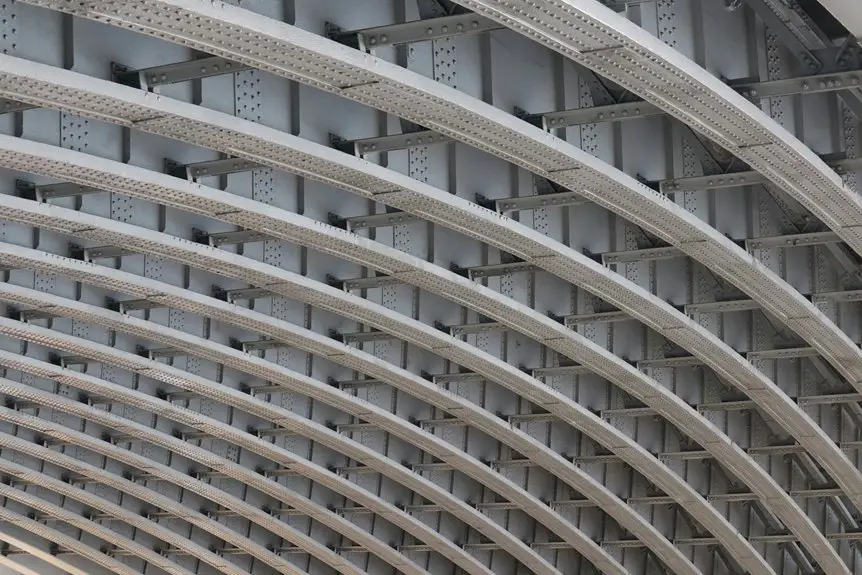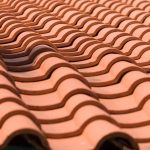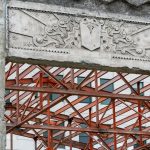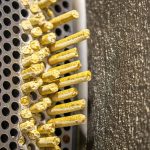Fiberglass scrim fabric is your go-to for reinforcing concrete and buildings with a strong, lightweight mesh that resists cracking and corrosion. It’s made by weaving protective-coated fiberglass yarns, offering excellent tensile strength and durability against moisture and chemicals. You’ll find it improves load distribution and extends structural life without adding bulk. Plus, it’s easy to apply and enhances overall stability. Keep exploring to uncover how it transforms construction projects and solves common challenges.
Table of Contents
Key Takeaways
- Fiberglass scrim fabric is a lightweight, strong reinforcement material resistant to moisture, heat, and chemicals, ideal for concrete and building applications.
- Its woven fiberglass yarn structure offers excellent tensile strength and dimensional stability, preventing shrinkage and warping in reinforced materials.
- The fabric enhances crack resistance and load distribution in concrete, improving durability and reducing structural failure risks.
- Proper application involves surface preparation, adhesive embedding, and mortar encapsulation to ensure maximum bonding and reinforcement effectiveness.
- Widely used in infrastructure and residential projects, fiberglass scrim extends structure lifespan, reduces maintenance, and improves overall structural integrity.
Understanding Fiberglass Scrim Fabric
Fiberglass scrim fabric serves as a strong, lightweight reinforcement material widely used in construction and manufacturing.
When you work with it, you’ll notice its grid-like structure made from woven fiberglass yarns. This design gives it excellent tensile strength and durability without adding much weight.
You’ll find it in products like wall coverings, roofing membranes, and concrete reinforcements, where it helps prevent cracking and structural damage.
The fabric is resistant to moisture, heat, and chemicals, so it performs well in harsh environments.
Because it’s non-corrosive and dimensionally stable, you can rely on it to maintain integrity over time.
Understanding these qualities helps you select the right fiberglass scrim fabric to enhance your project’s strength and longevity efficiently.
Manufacturing Process of Fiberglass Scrim
To create the strong and lightweight scrim fabric you rely on, manufacturers carefully weave fiberglass yarns into a grid pattern. This process starts with producing continuous fiberglass yarns, which are then coated with a protective finish to enhance durability. Next, these yarns are woven on looms that guarantee even tension and precise alignment. After weaving, the fabric undergoes heat setting to lock the structure and improve stability.
Here’s a quick overview of the manufacturing steps:
| Step | Description |
|---|---|
| Yarn Production | Continuous fiberglass strands made |
| Weaving | Yarns arranged into a grid pattern |
| Heat Setting | Fabric stabilized with heat |
This method guarantees you get consistent quality and maximum performance for reinforcement applications.
Properties and Characteristics of Fiberglass Scrim Fabric
Durability and flexibility define scrim fabric’s core qualities, making it an ideal choice for reinforcement tasks.
When you use fiberglass scrim, you benefit from its lightweight yet strong nature, which resists tearing and stretching under pressure. Its resistance to chemicals and moisture guarantees it holds up well in harsh environments, so you won’t worry about degradation over time.
The fabric also maintains dimensional stability, meaning it won’t shrink or warp, keeping your reinforcement consistent. Additionally, its open weave structure allows excellent adhesion with concrete and other building materials, enhancing overall performance.
Thanks to its non-corrosive and fire-resistant properties, fiberglass scrim offers long-lasting reliability, giving you a dependable solution for various construction and renovation projects.
How Fiberglass Scrim Enhances Concrete Strength
When you add fiberglass scrim to concrete, it helps reduce cracking by improving crack resistance.
It also spreads the load more evenly, boosting the structure’s overall strength.
Plus, it makes the concrete more durable against weather and wear over time.
Crack Resistance Improvement
Although concrete is strong under compression, it tends to crack under tension and stress. You can greatly reduce this vulnerability by incorporating fiberglass scrim fabric into your concrete mixes or overlays.
The scrim acts as a reinforcement mesh, distributing stress across a wider area and holding the structure together when cracks begin to form. This prevents small fissures from expanding into larger, structural problems.
Because fiberglass scrim is flexible and resistant to corrosion, it maintains its strength over time, unlike traditional steel reinforcement that can rust and degrade.
Load Distribution Efficiency
Beyond improving crack resistance, fiberglass scrim fabric plays a key role in distributing loads more evenly throughout concrete structures.
When you incorporate scrim into your concrete mix or overlay, it acts like a network of tiny reinforcements, spreading stress across a wider area. This means the concrete can handle heavier weights and resist deformation under pressure.
You’ll notice less localized strain because the scrim fabric transfers forces away from weak spots, reducing the risk of failure. By enhancing load distribution, fiberglass scrim helps your structures maintain integrity longer, even under dynamic or shifting loads.
Durability Against Weather
Since concrete structures constantly face harsh weather conditions, you need materials that boost their resilience.
Fiberglass scrim fabric enhances concrete’s durability by acting as a flexible reinforcement layer that resists cracking caused by temperature fluctuations, moisture, and freeze-thaw cycles.
When embedded in concrete, it improves tensile strength, preventing surface degradation from harsh weather.
You’ll also benefit from its resistance to corrosion and chemical damage, which often worsen with prolonged exposure to rain, snow, and UV rays.
This means your concrete stays intact and maintains structural integrity longer, reducing costly repairs.
Application Techniques for Building Reinforcement
Before applying fiberglass scrim, you’ll need to prepare the surface thoroughly to guarantee proper adhesion.
Next, carefully embed the scrim into the reinforcement material and follow the recommended curing process for maximum strength.
These steps are essential for achieving a durable and effective building reinforcement.
Surface Preparation Methods
When preparing a surface for fiberglass scrim fabric application, you need to guarantee it’s clean, dry, and free of any loose materials that could compromise adhesion.
Begin by removing dirt, dust, grease, and old paint using a wire brush, vacuum, or pressure washer, depending on the surface type. For concrete, you might need to grind or sand to create a slightly rough texture that improves bonding.
Make certain to repair any cracks or holes beforehand to ensure a smooth, stable base. Avoid moisture by letting the surface dry thoroughly, as dampness can weaken the fabric’s hold.
Proper surface preparation directly impacts the reinforcement’s durability and performance, so take the time to do it right before moving on to embedding the fiberglass scrim fabric.
Embedding and Curing Process
Although proper surface preparation sets the stage, embedding fiberglass scrim fabric correctly guarantees maximum reinforcement strength.
First, apply a thin, even layer of the chosen adhesive or mortar to the prepared surface. Next, press the scrim fabric firmly into this layer, smoothing out any wrinkles or air bubbles to ascertain full contact. Use a trowel or roller for consistent pressure.
Once embedded, cover the fabric with another layer of mortar or coating, fully encapsulating it. Then, allow the assembly to cure under recommended conditions—usually maintaining appropriate temperature and humidity levels.
Avoid disturbing the area during curing to prevent weak spots. By following these steps carefully, you’ll achieve a durable bond that enhances the structural integrity of your concrete or building surface.
Comparing Fiberglass Scrim With Other Reinforcement Materials
While fiberglass scrim offers excellent strength and flexibility, you might wonder how it stacks up against other common reinforcement materials like carbon fiber, polyester, or metal mesh.
Compared to carbon fiber, fiberglass scrim is more cost-effective but less stiff and lightweight. If budget matters, fiberglass scrim often wins.
Polyester scrim is cheaper but lacks fiberglass’s durability and resistance to chemicals, making fiberglass preferable for demanding environments.
Metal mesh provides high tensile strength but can corrode and add weight, whereas fiberglass scrim resists corrosion and stays lightweight.
Ultimately, fiberglass scrim balances cost, strength, and flexibility, making it a versatile choice, but your specific project needs will determine which material suits you best.
Benefits of Using Fiberglass Scrim in Construction
Because fiberglass scrim offers a unique combination of strength and flexibility, it’s an ideal material for construction projects that demand durability without added weight. When you use fiberglass scrim, you enhance crack resistance and improve structural integrity without compromising on ease of installation.
Here’s a quick overview of its benefits:
| Benefit | Description |
|---|---|
| Lightweight | Reduces overall material weight |
| Corrosion Resistant | Lasts longer in harsh environments |
| Easy to Handle | Simplifies installation and speeds up work |
Common Challenges and Solutions in Using Fiberglass Scrim
When you work with fiberglass scrim, you might face challenges like handling its delicate fibers or ensuring proper adhesion to surfaces. To prevent damage, handle the scrim gently and avoid sharp tools that can tear it. Wearing gloves helps protect both the fabric and your hands.
Achieving strong adhesion can be tricky; make sure surfaces are clean and dry before application. Use recommended primers or adhesives designed for fiberglass scrim to improve bonding.
Another common issue is ensuring the scrim lays flat without wrinkles—apply it slowly and use a roller to smooth out air bubbles. If you follow these tips, you’ll overcome typical obstacles and get the most out of fiberglass scrim in your construction projects.
Case Studies: Successful Projects Using Fiberglass Scrim
You’ll see how fiberglass scrim has reinforced bridges and highways, boosting infrastructure strength effectively.
In residential settings, it’s helped repair walls and prevent cracks, proving its versatility.
Let’s explore these successful projects to understand its real-world impact.
Infrastructure Strengthening Examples
Although infrastructure projects face numerous challenges, fiberglass scrim has proven to be a reliable solution for strengthening and extending the lifespan of various structures. You’ll find it effective in reinforcing bridges, tunnels, and highways, providing durability without adding significant weight. Its corrosion resistance also makes it ideal for harsh environments.
Here are some examples of infrastructure strengthened using fiberglass scrim:
| Project Type | Location | Outcome |
|---|---|---|
| Bridge Deck | California, USA | Increased load capacity by 30% |
| Tunnel Lining | London, UK | Enhanced crack resistance |
| Highway Pavement | Sydney, Australia | Reduced maintenance costs by 25% |
| Retaining Wall | Tokyo, Japan | Improved structural stability |
Using fiberglass scrim, you can boost infrastructure longevity efficiently and cost-effectively.
Residential Application Highlights
Since residential structures face unique challenges like moisture, temperature changes, and everyday wear, fiberglass scrim offers an effective way to reinforce walls, ceilings, and floors without major renovations.
Take, for example, a homeowner who strengthened their basement walls against moisture damage by embedding fiberglass scrim within a new plaster layer. This simple addition prevented cracks and mold growth.
Another case involved reinforcing ceiling joints in an older home, where scrim fabric added durability without altering the original design.
You can also use fiberglass scrim to fortify floor underlays, enhancing impact resistance and longevity.
These projects show how fiberglass scrim integrates seamlessly into residential settings, providing lasting protection and reducing maintenance costs, all while preserving your home’s aesthetics and structure.
Maintenance and Longevity of Fiberglass Reinforced Structures
When you invest in fiberglass reinforced structures, proper maintenance plays an essential role in extending their lifespan.
You should regularly inspect the surface for cracks, chips, or any signs of wear. Promptly addressing minor damages prevents more extensive deterioration.
Cleaning with mild detergents and avoiding harsh chemicals keeps the fiberglass scrim fabric intact and effective.
Also, make certain the structure is protected from prolonged UV exposure, as it can degrade the material over time. Applying UV-resistant coatings can help preserve its strength and appearance.
Frequently Asked Questions
Is Fiberglass Scrim Fabric Safe for Indoor Air Quality?
You can trust fiberglass scrim fabric to be safe for indoor air quality when properly installed. It doesn’t emit harmful chemicals or odors, so you won’t have to worry about it affecting your home’s air quality.
Can Fiberglass Scrim Fabric Be Recycled After Use?
You can recycle fiberglass scrim fabric, but it’s not common due to limited facilities. You’ll want to check local recycling programs or specialized centers to handle it properly and reduce environmental impact after use.
What Is the Environmental Impact of Producing Fiberglass Scrim?
You might think producing fiberglass scrim is clean, but it’s not. It consumes energy, emits CO2, and uses raw materials. You’ll want to balance benefits with environmental costs and explore recycling options to reduce impact.
Are There Any Health Risks When Handling Fiberglass Scrim Fabric?
You might experience skin irritation or respiratory issues if you handle fiberglass scrim without protection. Always wear gloves, long sleeves, and a mask to avoid itching, rashes, or inhaling tiny fibers that can cause discomfort.
How Does Fiberglass Scrim Affect the Thermal Insulation of Buildings?
You might not expect it, but fiberglass scrim can improve thermal insulation by reinforcing materials without adding significant heat transfer. So, when you use it, your building stays sturdier and better insulated, saving energy efficiently.
- Jack-O-Lantern Tie-Dye: a Complete Tutorial With Folding Tips - July 13, 2025
- How to Fold a Perfect Shamrock for Tie-Dyeing - July 13, 2025
- Step-by-Step Sunburst Tie-Dye for Bright, Bold Designs - July 13, 2025







